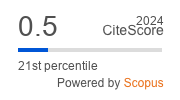Antihypoxic activity of zinc acetate complexes with N-allenyl- and N-isopropenylimidazoles on hypoxia models of various ethiology
Abstract
А comparative study of antihypoxic effect of complex compounds of zinc acetate with N-allenyland N-isopropenylimidazole, complexes immobilized on the sulfated arabinogalactan, and well-known antihypoxants, and/or antioxidants: ethomerzol, mexidol and nooglutyl has been conducted on nonlinear white mice-males in experiments. It is shown that in conditions of acute hypoxia of different Genesis, the complexes of zinc with N-alkenylmidazoles showed a pronounced antihypoxic effect in the dose range of 10–100 mg/kg, i/p, on 16–317% life span of animals increasing compared with the control groups of animals that surpasses the effect of known antihypoxants: etomerzol (25–100 mg/kg, i/p), mexidol (100 mg/kg, i/p) and nooglutyl (25–100 mg/kg, i/p). Complexes immobilized on the sulfated arabinogalactan were ineffective.
About the Authors
S. A. ShakhmardanovaRussian Federation
Swetlana Shakhmardanova, Candidate of Biological Sciences, Associate Professor, Department of Pharmacology
13/1, Nikitsky Boulevard, Moscow, Russia, 121019
I. N. Parshina
Russian Federation
Doctor of Chemical Sciences, chief specialist, the Laboratory of Unsaturated Heteroatomic Compounds
B. A. Trofimov
Russian Federation
Doctor of Chemical Sciences, Professor, Acad. RAS, Head of Laboratory of Unsaturated Heteroatomic Compounds
P. A. Galenko-Yaroshevsky
Russian Federation
Doctor of Medical Sciences, Head of Department of Pharmacology
V. V. Tarasov
Russian Federation
Candidate of Pharmaceutical Sciences, Head of Department of Pharmacology
M. I. Maksimov
Russian Federation
Doctor of Medical Sciences, Professor, Department of Pharmacology
S. S. Sologova
Russian Federation
Candidate of Biological Sciences, Associate Professor at the Department of Pharmacology
References
1. Litvitsky P.F. Extreme and terminal conditions. Shock. Sechenovsky Vestnik. 2010; 2: 95–105 (in Russian).
2. Samoilov N.N., Katunina N.P., Lebedeva S.A. et al. The study of antihypoxic activity of new imidazol derivated compositions on the model of acute hypoxia with hypercapnia. Kuban Sci. Med. Vestnik. 2009; 113(8): 62–65 (in Russian).
3. Stratienko E.N., Bogus S.K., Katunina N.P. et al. The study of antihypoxic activity of new complex metal alkenilimidazol derivated compositions. Kuban Sci. Med. Vestnik. 2009; 8: 76–78 (in Russian).
4. Shakhmardanova S.A., Galenko-Jaroshewsky P.A. Metal complexes derivatives of 1-alkenilimidazol. Antihypoxic properties, mechanism of action, prospects of clinical application. Krasnodar: Education-South; 2015: 267 (in Russian).
5. Kelleher S., McCormick N., Velasquez V., Lopez V. Zinc in Specialized Secretory Tissues: Roles in the Pancreas, Prostate, and Mammary Gland. Adv. Nutr. 2011; 2(2): 101–111.
6. Malhotra A., Dhawan D. Current view of zinc as a hepatoprotective agent in conditions of chlorpyrifos induced toxicity. Pesticide biochemistry and physiology. 2014; 112: 1–6.
7. Powell S.R. The antioxidant properties of zinc. J. Nutr. 2000; 130: 1447–1454.
8. Baykalova L.V., Tarasova O.A., Ziryanova I.A. et al. Metal complexes 1-alkenylimidazole. J. of General Chem. 2002; 72(8): 1378–1382 (in Russian).
9. Ziryanova I.A., Baykalova L.V., Tarasova O.A. et al. Complex compounds based on 1-isopropenylimidazole and pyrazole. J. of General Chem. 2005; 75(8): 1353–1359 (in Russian).
10. Arzamastsev E.V., Gusʼkova T.A., Berezovskaya I.V. et al. Guidelines for the study of General toxic effect of pharmacological substances. In: Guidance on experimental (preclinical) study of new pharmacological substances. 2 nd. rev. Moscow; 2005: 41–54 (in Russian).
11. Berezovskaya I.V. Classification of chemical substances in the parameters of acute toxicity for parenteral injection methods. Pharm. Chem. J. 2003; 3: 32–34 (in Russian).
12. Lukyanova L.D. (ed.). The Medical recommendations for a pilot study of drugs proposed as antihypoxic tools. Moscow; 1990: 18 (in Russian).






































